Effects of nicotine on depressive-like behavior and hippocampal volume of female WKY rats
- PMID: 19800382
- PMCID: PMC2814982
- DOI: 10.1016/j.pnpbp.2009.09.024
Effects of nicotine on depressive-like behavior and hippocampal volume of female WKY rats
Abstract
The observed high incidence of smoking amongst depressed individuals has led to the hypothesis of 'self medication" with nicotine in some of these patients. The inbred Wistar-Kyoto (WKY) rats exhibit depressive-like characteristics as evidenced by exaggerated immobility in the forced swim test (FST). One aim of this study was to investigate whether nicotine may have an antidepressant-like effect in these animals. Moreover, because of human postmortem studies indicating a reduction of the hippocampus volume in depressed patients, it was of interest to determine whether such an anatomical anomaly may also be manifested in WKY rats and whether it would be affected by chronic nicotine treatment. Adult female WKY and their control Wistar rats were administered nicotine consecutively (0.2 mg/kg, i.p., once or twice daily for 14 days) and their activity in an open field, as well as their immobility in FST were assessed either 15 min or 18 h after the last injection. Another set of animals was treated twice daily with 0.2 mg/kg nicotine for 14 days and sacrificed on day 15 for stereological evaluation of the hippocampal volume. When tested 15 min after the last injection, once or twice daily nicotine exacerbated the immobility in the FST in WKY rats only. When tested 18 h after the last injection, only twice daily nicotine treatment resulted in less immobility in the FST in WKY rats. Open field locomotor activity was not affected by any nicotine regimen. WKY rats had significantly less hippocampal volume (approximately 20%) than Wistar rats which was not altered by nicotine. These findings further validate the use of WKY rats as an animal model of human depression and signify the importance of inherent genetic differences in final behavioral outcome of nicotine.
Copyright 2009. Published by Elsevier Inc.
Figures
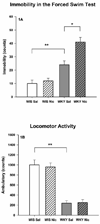
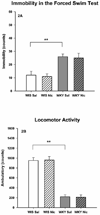
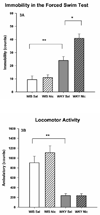
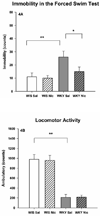
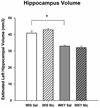
Similar articles
-
Antidepressant-like effects of nicotine and reduced nicotinic receptor binding in the Fawn-Hooded rat, an animal model of co-morbid depression and alcoholism.Prog Neuropsychopharmacol Biol Psychiatry. 2009 Apr 30;33(3):398-402. doi: 10.1016/j.pnpbp.2008.09.010. Epub 2008 Sep 19. Prog Neuropsychopharmacol Biol Psychiatry. 2009. PMID: 18835320 Free PMC article.
-
Antidepressant-like effects of buprenorphine in rats are strain dependent.Behav Brain Res. 2015 Feb 1;278:385-92. doi: 10.1016/j.bbr.2014.10.014. Epub 2014 Oct 18. Behav Brain Res. 2015. PMID: 25453747 Free PMC article.
-
Desipramine blocks alcohol-induced anxiety- and depressive-like behaviors in two rat strains.Pharmacol Biochem Behav. 2008 Nov;91(1):97-103. doi: 10.1016/j.pbb.2008.06.016. Epub 2008 Jun 29. Pharmacol Biochem Behav. 2008. PMID: 18640149 Free PMC article.
-
Antidepressant-like effects of curcumin in WKY rat model of depression is associated with an increase in hippocampal BDNF.Behav Brain Res. 2013 Feb 15;239:27-30. doi: 10.1016/j.bbr.2012.10.049. Epub 2012 Nov 8. Behav Brain Res. 2013. PMID: 23142609 Free PMC article.
-
Role of cortical alpha-2 adrenoceptors in alcohol withdrawal-induced depression and tricyclic antidepressants.Drug Alcohol Depend. 2017 Jun 1;175:133-139. doi: 10.1016/j.drugalcdep.2017.03.004. Epub 2017 Apr 4. Drug Alcohol Depend. 2017. PMID: 28414989 Free PMC article.
Cited by
-
Retinal Nerve Fiber Layer Thickness Measurement by Spectral-Domain Optical Coherence Tomography in Patients with Major Depressive Disorder.Noro Psikiyatr Ars. 2017 Mar;54(1):62-66. doi: 10.5152/npa.2015.10115. Noro Psikiyatr Ars. 2017. PMID: 28566961 Free PMC article.
-
Differences in vulnerability to nicotine-induced kindling between female and male periadolescent rats.Psychopharmacology (Berl). 2013 Jan;225(1):115-26. doi: 10.1007/s00213-012-2799-5. Epub 2012 Jul 11. Psychopharmacology (Berl). 2013. PMID: 22782460
-
Dual pharmacological inhibitor of endocannabinoid degrading enzymes reduces depressive-like behavior in female rats.J Psychiatr Res. 2020 Jan;120:103-112. doi: 10.1016/j.jpsychires.2019.10.010. Epub 2019 Oct 11. J Psychiatr Res. 2020. PMID: 31654971 Free PMC article.
-
From microRNA to protein, linking the neurotrophic hypothesis of depression to the Wistar Kyoto rat.Neurosci Appl. 2023 Aug 19;2:101131. doi: 10.1016/j.nsa.2023.101131. eCollection 2023. Neurosci Appl. 2023. PMID: 40655973 Free PMC article.
-
Duality of Antidepressants and Neuroprotectants.Neurotox Res. 2016 Jul;30(1):1-13. doi: 10.1007/s12640-015-9577-1. Epub 2015 Nov 27. Neurotox Res. 2016. PMID: 26613895 Free PMC article. Review.
References
-
- Andreasen JT, Olsen GM, Wiborg O, Redrobe JP. Antidepressant-like effects of nicotinic acetylcholine receptor antagonists, but not agonists, in the mouse forced swim and mouse tail suspension tests. J Psychopharmacol. 2009a;23:797–804. - PubMed
-
- Andreasen JT, Redrobe JP. Antidepressant-like effects of nicotine and mecamylamine in the mouse forced swim and tail suspension tests depend on strain and test, but not sex. Behav Pharm. 2009b;20:286–295. - PubMed
-
- Blalock JA, Robinson JD, Wetter DW, Schreindorfer LS, Cinciripini PM. Nicotine withdrawal in smokers with current depressive disorders undergoing intensive smoking cessation treatment. Psychol Addict Behav. 2008;22:122–128. - PubMed
-
- Buisson B, Bertrand D. Nicotine addiction: the possible role of functional upregulation. Trends Pharmacol Sci. 2002;23:130–136. - PubMed
Publication types
MeSH terms
Substances
Grants and funding
LinkOut - more resources
Full Text Sources
Medical
Miscellaneous

